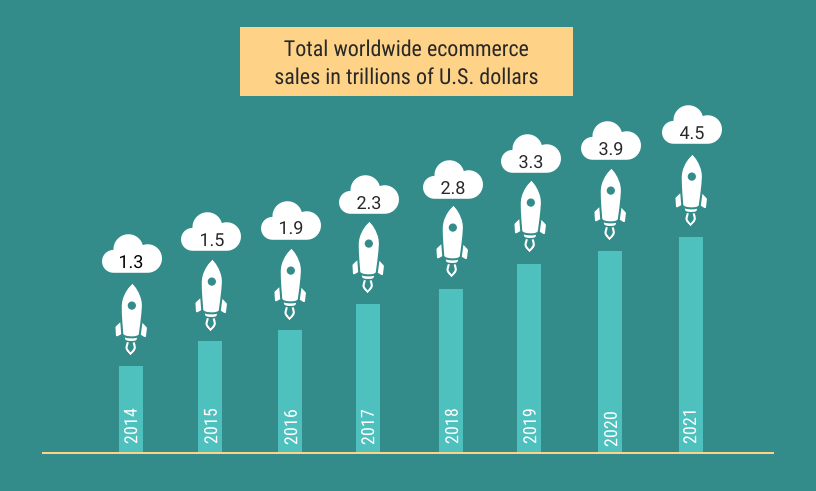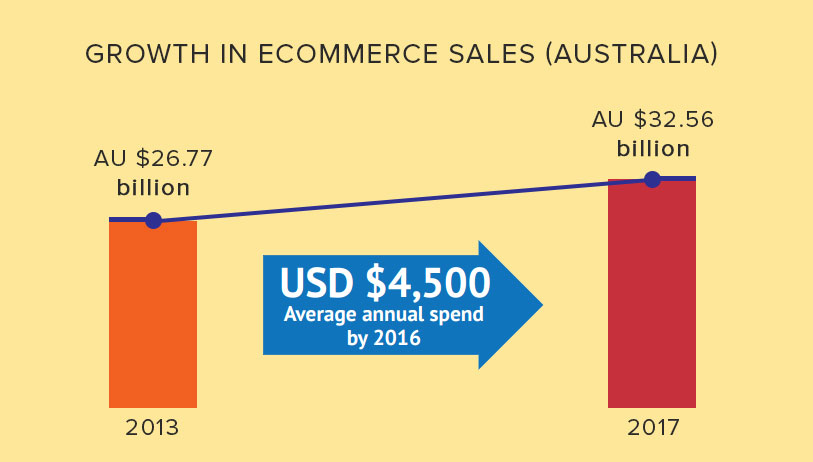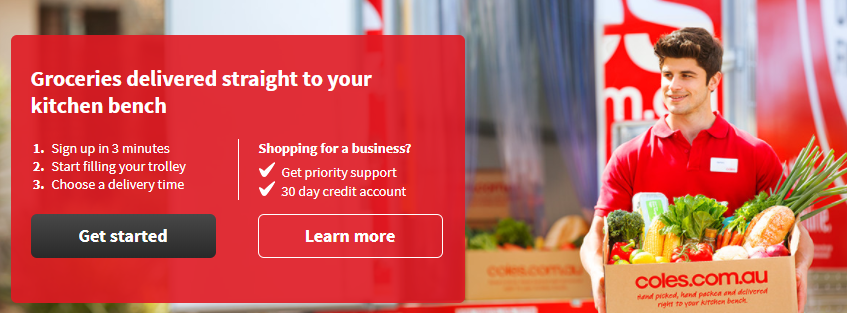
As little as 20 years ago, the idea of logging on to your computer, pulling up the internet to find a product you need and submitting your credit card details in the hope said product turns up on your doorstep a few days later would have seemed genuinely insane.
But as of 2017, 85% of Australians are connected to the internet and around 12.1 million Aussies are on social media.
Unquestionably, the future of retail growth is in ecommerce.
The convenience for the shopper and the reduction in overheads for the retailer are two primary drivers of Australian ecommerce growth, and with steadily decreasing costs of logistics and delivery – this growth trend is set to continue for several years yet.
Megastores like Coles, Woolworths, Target and Kmart have opened up ecommerce websites to take advantage of the increased margins of online retail and the ability to serve consumers around the clock.
Who doesn’t love walking into Kmart at night for a dish rack and leaving with $300 worth of stuff?
Well, you can do it online now. You don’t have to brave the traffic, find a carpark, wait in line, or lug your goods to the car. You don’t even have to leave your couch.
And Kmart doesn’t have to pay that spotty 17-year-old to slump by the counter all night either.
The world of ecommerce is booming and we want to prove to you exactly why now is the time to capitalise on the sustainable growth of Australian ecommerce.
We’ve collected four of the most compelling statistics about ecommerce in Australia.
- If you’ve been thinking about starting your own online store – this should be the inspiration you need
- If you’re trying to convince your boss to invest in ecommerce – these are the stats you need to highlight in your presentation slides
- If you’ve taken the first tentative steps into the world of ecommerce – you can be confident in your continued investment
Use these statistics to help inspire you and your business to strengthen your investment in ecommerce and capitalise on the long term growth of online retail.
#1 Global ecommerce sales will reach $4.5 trillion by 2021 – and Aussies are already top ten competitors
There’s no doubt about it: if you’re looking for sustainable long-term growth – ecommerce is the business to be in.
It’s the retail industry’s version equivalent of striking oil, and with many industries still struggling to adapt, there’s still plenty of reserves left to be found and mined.
Global ecommerce sales are rising at top speed and according to Statista, there’s no stop in sight. The statistics portal anticipates sales to rise to $2.8 trillion in 2018 and $4.5 trillion in 2021.
Image source: Shopify
We’re looking at ecommerce sales doubling from 2017’s minuscule $2.3 trillion within four years. It’s an exciting time to be in ecommerce.
Australia is performing well alongside global powerhouses like China, America and the United Kingdom. According to economics blog Consultancy UK, we’re sitting in tenth position for ecommerce sales worldwide, just below Belgium and Russia.
We’re also expected to produce $32.56 billion in ecommerce sales this year alone and if global trends are correct, we’re on the path to smashing economic records in the near future.
Image source: WebAlive
Australia is becoming an ecommerce powerhouse.
It’s time to cash in on this sweet growth potential.
Check out our blog on finding a life-changing ecommerce business idea and get on the bandwagon!
#2 In 2017, online shopping increased by 10% while in-store foot traffic increased by just 3%
Running a physical, nine-to-five store?
It might be time to add an online store to your retail operations.
The NAB Online Retail Index Report 2017 discovered online shopping has increased by almost 10% in Australia over the past year while in-store foot-traffic has only increased by 3%.
It’s a depressing statistic and even some of Australia’s major retailers are failing to perform better than many online businesses.
According to ABC News, Payless Shoes and Topshop are among a slew of stores going into administration after a long fight against online retail competitors.
Some traditional retailers are competing with their own online stores. Coles and Woolworths offer online shopping, allowing their customers to add groceries to a virtual cart, select a time for delivery and have their shopping delivered straight to their door.
Customers can even get free shipping on orders over $100.
Image source: Coles
Traditional business owners are going to have to get creative if they want to compete with online retailers.
If you’re operating traditional bricks and mortar stores without an online retail component – you need to expect disruption from ecommerce innovators with fewer overheads, higher margins and almost non-existent barriers to entry.
#3 Aussie shoppers make more purchases online in the evening
What better way to celebrate the end of a work day/week/month than with a sneaky online shopping spree?
29% of consumers make purchases online between 7-10pm while 18% shop between 2-5pm.
A collection of innovative online retailers are developing some novel strategies to capitalise on the after-dark spike in online shopping.
- Vogue runs an enormous Online Shopping Night which offers readers discounts to hundreds of high fashion retailers including Myer, Glassons and Dharma Bums Activewear. The attractive discounts, luxurious brands and exclusivity of Vogue Online Shopping Night makes fashionistas everywhere go wild for an evening of bargain hunting.

- Boohoo Australia uses a similar method of drawing in customers. The international fashion brand offers ridiculous discounts and sales on a daily basis – sometimes even multiple different offers per day of up to 70% off. The offers have a visible deadline countdown, using urgency to remind (or gently pressure) customers to take advantage of the discount despite there being another discount waiting just around the corner.

There’s something to learn from ecommerce stores like Boohoo: offer rewards and incentives to capitalise on traffic peaks.
Monitor your analytics closely and make urgency your friend.
Ecommerce software provider, Workarea know the importance of these behavioural insights. Their platform allows retailers to analyse conversion and engagement statistics and subsequently make smarter decisions.
You should be using the capabilities of your analytics program to:
- Schedule any promotions or flash sales to run during the most profitable night of the week, at the most popular online shopping time
- Adjust your PPC advertising budget to focus your spend on high traffic nights and times
- Trigger your email and social promotions to publish at the peak average engagement times for each specific channel – but run any limited time promotions to expire at the end of the night, urging customers to jump on to your store in their favoured online shopping times
#4 Get your shipping sorted for Christmas: 2016 saw 34 million domestic parcel deliveries during the holiday season
Christmas hysteria really works wonders for ecommerce businesses.
34 million domestic parcels were delivered over the Christmas period in 2016 and 5.6 million parcels shipped from overseas.
Manic Monday (the last Monday before Christmas) is also typically the busiest day of the year for online shopping deliveries.
It’s crucial to have your shipping practices under control. We have a range of shipping integration plugins available for download which can help get the process running smoothly.
Our WooCommerce, Shopify and Magento plugins allow business owners to bulk export shipping information to Transdirect and get couriers on the job almost instantly.
There’ll be less data entry and loads more time to focus on customer service over the hectic holiday season.
If your customers get their parcels before Christmas Day, you might even see them coming back for more.
Want to learn more about creating repeat customers this Christmas?
Check out our guide to designing an ecommerce website to maximise repeat sales and amp up your customer retention.
Invest in your patch of ecommerce growth and learn how to maximise your first-mover advantage
There’s nothing more valuable to an aspiring business owner than knowledge and experience.
It’s vital to know the game you’re playing, who you’re up against and what the odds are of succeeding. If you want to capitalise on the future growth of the Australian ecommerce industry – you need to keep innovating and optimising your online shopping experience at every opportunity.
More and more Australians are buying online each and every day
The future looks bright and prosperous for Aussie ecommerce business owners.
The market is striving and those retailers prepared to invest proactively are poised to reap the rewards.
If you can create the best possible ecommerce customer experience for your retail niche – you’re set for a nice chunk of those trillions of dollars of future ecommerce growth.


